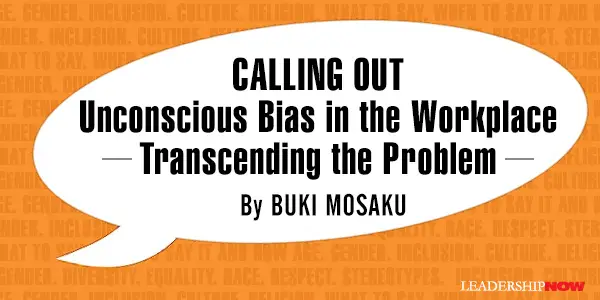 |
 |
07.28.23

Calling Out Unconscious Bias in the Workplace – Transcending the Problem
STATISTICS show that minorities and marginalized groups repeatedly experience career-stifling unconscious bias at many points throughout their working lives. Women and ethnic monitories, for example, often find it hard to climb the career ladder — a fact borne out in the significant underrepresentation of both groups in senior leadership roles. Minorities also report being passed over in favor of white or male counterparts when the “good” assignments are given out. They’re also less likely to be given access to the multitude of career development opportunities that make a difference in earning potential. Across sectors, minorities report that they:
Certainly, many employers have taken some important steps to deal with career-stifling bias. While top-down initiatives will bear fruit in the long term, the trickle-down effect is too slow for those already falling victim to unconscious workplace bias. So, what’s the answer? Here are three power actions that differentiate high-performing minorities in calling out and navigating career-stifling unconscious bias in the workplace: 1. Understand the Problem of Unconscious Bias in the Workplace On the basis that you can’t successfully address or tackle a problem that you don’t fully understand, it behooves everyone in the organization to be cognizant with this topic. There are two forms of career-stifling unconscious bias: Directional bias is unconsciously directed toward minorities in the workplace by leaders, potential clients, and clients based on conditioned negative stereotypes. This could show up as a lack of trust when potential clients hear an untraditional accent or are confronted with a female as opposed to a male practitioner. It can also reveal itself when minorities are overlooked for senior roles or for high-profile projects. Reverse bias, is when a minority misinterprets unfavorable decisions or behaviors as driven by unconscious bias when they aren’t, in which case they become the perpetrator of bias as opposed to the victim. For instance, an employee representing a marginalized group may presume a colleague has a problem with their accent when in reality, there’s no problem. Or, a minority senses unconscious discrimination when not being tapped for a promotion when it’s a case of simply not meeting the requirements of the role. With this understanding, minorities can allow for misinterpretations of sensed bias and, in doing so, more effectively navigate sensed directional bias without turning into a perpetrator of bias themselves and invoking defensive fragility from the presumed perpetrator — in other words, getting the other person’s “back up.” 2. Call Out Sensed Unconscious Bias Whenever you sense unconscious bias towards yourself or others, call it out in the moment. Don’t wait. If you don’t, you’re part of the problem. If you do, you’re part of the solution. Here’s a step-by-step way to effectively call it out:
3. Transcend the Problem The first two practical steps are focused on navigating everyday bias in the moment, however, transcending workplace bias rapidly dissipates the issue in real time and completely removes the problem. To do that, accept the unequivocal multidirectional nature of workplace bias. This means always allowing for the potential that you’ve misinterpreted the situation regardless of your certainty — that you might be engaging in reverse bias. When you do this, you strategically position yourself to advantageously call out bias any time you sense it without being accusatory in your approach and invoking defensive fragility in the sensed perpetrator. When you apply these three powerful actions, your vision, and wisdom are unimpaired by majority guilt or minority pain and retribution. You focus on collaborative, progressive bias navigation in the moments you sense career-stifling workplace bias. Practice navigating everyday bias until the approach becomes second nature. Don’t be shy — give it a try!  
Posted by Michael McKinney at 05:14 AM
|
BUILD YOUR KNOWLEDGE
 

How to Do Your Start-Up Right STRAIGHT TALK FOR START-UPS 
Grow Your Leadership Skills NEW AND UPCOMING LEADERSHIP BOOKS 
Leadership Minute BITE-SIZE CONCEPTS YOU CAN CHEW ON 
Classic Leadership Books BOOKS TO READ BEFORE YOU LEAD |